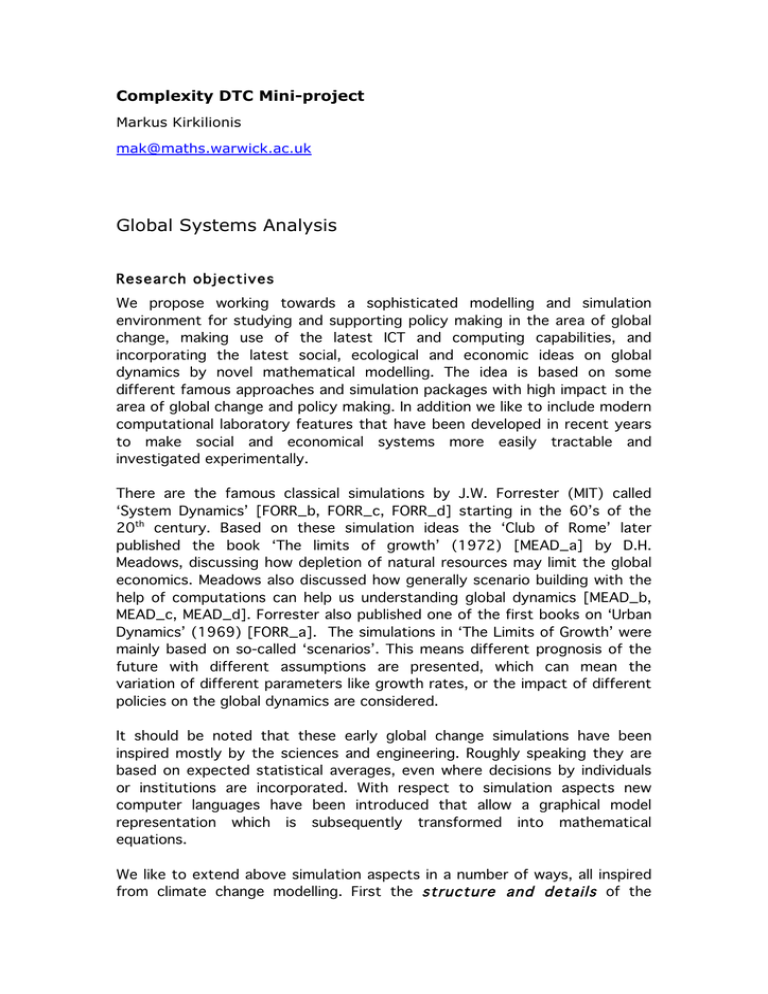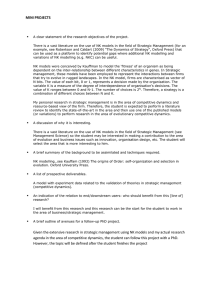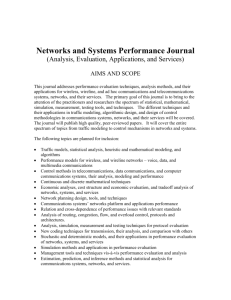Global Systems Analysis Complexity DTC Mini-project
advertisement

Complexity DTC Mini-project Markus Kirkilionis mak@maths.warwick.ac.uk Global Systems Analysis Research objectives We propose working towards a sophisticated modelling and simulation environment for studying and supporting policy making in the area of global change, making use of the latest ICT and computing capabilities, and incorporating the latest social, ecological and economic ideas on global dynamics by novel mathematical modelling. The idea is based on some different famous approaches and simulation packages with high impact in the area of global change and policy making. In addition we like to include modern computational laboratory features that have been developed in recent years to make social and economical systems more easily tractable and investigated experimentally. There are the famous classical simulations by J.W. Forrester (MIT) called ‘System Dynamics’ [FORR_b, FORR_c, FORR_d] starting in the 60’s of the 20th century. Based on these simulation ideas the ‘Club of Rome’ later published the book ‘The limits of growth’ (1972) [MEAD_a] by D.H. Meadows, discussing how depletion of natural resources may limit the global economics. Meadows also discussed how generally scenario building with the help of computations can help us understanding global dynamics [MEAD_b, MEAD_c, MEAD_d]. Forrester also published one of the first books on ‘Urban Dynamics’ (1969) [FORR_a]. The simulations in ‘The Limits of Growth’ were mainly based on so-called ‘scenarios’. This means different prognosis of the future with different assumptions are presented, which can mean the variation of different parameters like growth rates, or the impact of different policies on the global dynamics are considered. It should be noted that these early global change simulations have been inspired mostly by the sciences and engineering. Roughly speaking they are based on expected statistical averages, even where decisions by individuals or institutions are incorporated. With respect to simulation aspects new computer languages have been introduced that allow a graphical model representation which is subsequently transformed into mathematical equations. We like to extend above simulation aspects in a number of ways, all inspired from climate change modelling. First the structure and details of the models need to be extended. As an example we like to mention demographical structure like age or educational distributions of a population. These distributions are highly relevant for systems dynamics and need therefore to be represented in the models. Secondly the development of climate change models have shown that different sub-modules describing sub-processes need constantly to be extended or changed in order to increase predictability. This means the simulation environment needs to be highly modular and hierachically layered . Finally at the same level of model hierarchy (for example the top layer of general circulation models, GCMs) climate change modelling has shown that different models perform differently well in certain parts of predictability. Based on this experience it has become practice to run several structurally different prediction models in parallel and compare results. We like to achieve the following objectives: • • • • • Provide a complete and novel systems analysis framework adapted to describe the global system. This framework should be able to reflect the multi-level and multi-scale nature of the global system. Provide a generic computational form of the respective modular mathematical model. Explain the predictive potential of the framework, in dependence on input data. Provide estimates about the accuracy of prediction when validated with historic data. Provide mathematical tools for bifurcation analysis. As the predictive model should allow for scenario building we must investigate the modules of the mathematical framework with respect to structural perturbations, i.e. different assumptions. The simplest are variations of parameter values of the model. We will be able to detect so-called ‘tipping points’ which play a crucial role in climate research. These are states of the model which by no policy interference allow the system to come back to a ‘desired’ state. Why is it interesting? In general this is interesting because we can have a fresh look at global systems dynamics given the progress in mathematical modelling. The fundamental mathematical class of equations or model framework we will use for this project are so-called ‘structured’ population models, often also called physiologically structured population models (PSPMs). This class of equations can be formulated in different ways mathematically. Its origins are so-called Volterra integral equations, well known in the study of demographical problems. As in classical demography we see the need to consider distributions of all or most model states, for example the age distribution of the entire world population – indeed divided into regions. As it is well known the age-distribution of a population alone gives much better predictive power for population growth or decline than just simply average age. We like to use this principle also for other state variables than population size, for example also for GDP (gross domestic product) which can be distributed over several industrial sectors in each country. As we see from the age distribution of China in 2009 (see Figure) we need often discretely cluster distributions in addition, for example we gain much more predictive power for future age distributions if we divide a population in addition into male and female. This will be one of the major departures from the systems analysis of the 1960’s: we will not in general use only expectations, but consider full distributions where possible (i.e. where data are available). Figure: The population age distribution of China in 2009. Discrete and continuum structures. As we have seen elementary global systems states can be either discretely or continuum structured. Structuring a human population for example can be done in several ways. Indeed age is an obvious choice, but it would not have much predictive power in terms of economical activity of a population. We will need other structuring variables, such as income, and indeed also education, finally profession etc. Profession is a good example that not all such structuring variables will form a continuum, and some of them might indeed be themselves multi-dimensional. The mathematical background is that not all relevant properties will be quantifiable by a single real number like ‘age’. Such a characterisation is indeed a statistical question in most cases. Multi-level approach, Nonlinearity A global systems analysis must be multi-level, i.e. proceed from ‘microscopic’ to ‘macroscopic’ states. Fortunately our proposed mathematical framework satisfies this requirement. For example our human populations will be structured by individuals (or rather ‘age-cohorts’) that build up the population. The total population state at time t will be the integrated contribution from all individuals at time t, or in a statistical sense the first moment of the distribution. The global system is largely nonlinear, i.e. it contains various feedback loops between the state variables of the model. We will need to incorporate feedback loops into our framework – which is fortunately possible. We will need to investigate the consequences or sensitivities each feedback loop will imply. Discretisation of the continuum, agent-based modelling Unfortunately we will not directly be able to implement simulation models using continuum distributions. We will need to approximate the equations with a discrete distribution without making too much errors. Fortunately the numerical treatment of PSPMs has made considerable advancements in the last decades, a fact that triggered this proposal, and which is indeed also a big step forward when compared with the systems analysis of the 1960’s and 1970’s. We will use cohort expansions. The basic idea is to approximate a continuum distribution of a structuring property (like ‘size’) by assemblies of individuals (or elementary components, like ‘firms’) which all have identical or very close to identical initial conditions. We then follow the changes of these discrete cohorts over time by following their aging and developing process. Moreover we keep track of the regeneration process, where new cohorts are built over time (‘renewal equations’). Essentially these cohorts can then be interpreted as agents in the classical computer science and social science sense. They usually will experience continuum input like growth rates (which requires a second discretisation of time), but an eventbased simulation is equally possible. Techniques required. - Mathematical Modelling - Especially Population dynamics, Demography - Numerical Analysis - Computing (with support). Prospective deliverables. - Building blocks and concepts to understand the global system. - A small example of a demographic process including level of education. Who should benefit from this research? - Complex systems scientists - Policy makers - Economists, social scientists, ecologists. Outline of avenues for a follow-up PhD project. The project has potential for several PhD so a thesis must focus on some aspect of this research. We have international connection to studies on global demography (IIASA, Austria), global economics (Kiel Institut für Weltwirtschaft, Germany), etc. References: [FORR_a] Forrester, J. W. and Karnopp, D. C. (1971): Urban dynamics. Journal of Dynamic Systems, Measurement, and Control. 93, 128. [FORR_b] Forrester, J. W. (1998): Designing the future. Work presented at Universidad de Sevilla. 15. [FORR_c] Forrester, J. W. (2007): System dynamics—the next fifty years. System Dynamics Review. 23, 2-­‐3, 359-370. [FORR_d] Forrester, J. W. (2007): System dynamics-a personal view of the first fifty years. System Dynamics Review. 23, 2-3, 345-358. [MEAD_a] Meadows, D. H. (1972): The Limits of Growth. A Report for The Club of Rome. [MEAD_b] Meadows, D. H. (1991): The global citizen. Island Pr. [MEAD_c] Meadows, D. H. (2001): Biodiversity: The key to saving life on earth. Environmental Ethics. 206–208. [MEAD_d] Meadows, D. H., Meadows, D. L., and Randers, J. (1992): Beyond the limits: Confronting global collapse, envisioning a sustainable future. Chelsea Green Pub. Co. Meadows, D. H. and Robinson, J. M. 2002. The electronic oracle: computer models and social decisions. System Dynamics Review. 18, 2, 271-308. [DÖRN_a] DÖRNER, D. (2001): Strategies in a Complex Game and their Background. In: Altmann, Erik M., Cleeremans, Axel, Schunn, Christian D. & Grey, Wayne., Proceedings of the 2001 Fourth International Conference on Cognitive Modelling. July 26 – 28, 2001. Mahwah, New Jersey. Lawrence Erlbaum Associates [SELT_a] SELTEN, R. (1988): Models of Strategic Rationality, Theory and Decision Library, Series C: Game Theory, Mathematical Programming and Operations Research, Dordrecht-Boston-London: Kluwer Academic Publishers. [MILG_a] Milgram, S. (1964): Group pressure and action against a person. Journal of Abnormal and Social Psychology. 69, 2, 137-143. [MILG_b] Milgram, S. (1974): The experience of living in cities. Crowding and behavior. 167, 41. [MILG_c] Milgram, S., Sabini, J., and Silver, M. (1992): The individual in a social world: essays and experiments. McGraw-Hill New York.


